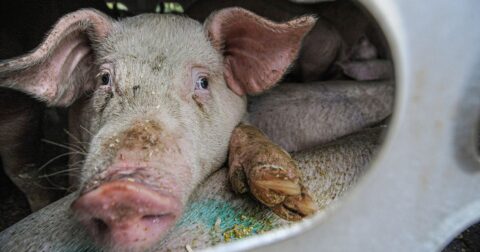Explainer
Are Organized Animal Rebellions Really a Thing?
Animal Behavior•6 min read
Reported
A decade of research on animal consciousness should influence their legal status, experts say.


Words by Gabriella Sotelo
A coalition of scientists, philosophers and other experts gathered at New York University last month to unveil a new declaration about the evolving science of animal consciousness. While consciousness can mean different things, at the heart of the question is whether animals, like cows and chickens, but also insects and fish, can experience pain or pleasure. The declaration is currently available online for researchers with relevant experience to sign. More than 150 people in various fields have signed on as of the publication date of this article, according to the website.
The basis of the New York Declaration on Animal Consciousness: there is “strong scientific support” for animal consciousness in mammals and birds, and a ‘realistic possibility’ of conscious experience in vertebrates, like reptiles, and even many invertebrates like insects. The hope, as expressed by many researchers at the April 19 event, was to reach broad agreement on which animals possess the capacity of a conscious experience.
Most of us humans tend to mostly be aware of consciousness in the animals humans have a close relationship with, like dogs or cats, said Anna Wilkinson Professor of Animal Cognition at the University of Lincoln, at the event. It’s also easy to discount animal consciousness in creatures we aren’t that familiar with, Wilkinson explained. “We’ve recently done a little bit of work that as animals get further away from humans on the evolutionary scale,” she said at the event, “we perceive them as both being less cognitive and having less emotions.” The declaration challenges these perceptions, by attributing consciousness to many of the animals humans aren’t usually concerned with, like insects.
While the first point in the declaration is that many scientists believe mammals and birds have conscious experiences, it may be the second that has greater implications. “The empirical evidence indicates at least a realistic possibility of conscious experience in all vertebrates (including reptiles, amphibians, and fishes) and many invertebrates (including, at minimum, cephalopod mollusks, decapod crustaceans, and insects),” reads the declaration. There are plenty of examples: crows can report what they see on their flights when trained, octopus know when to avoid pain and insects, like bees, can play (and even learn from each other).
Lars Chitka, a professor of Sensory and Behavioural Ecology at Queen Mary University of London, pointed to bees as an example of insects where scientists have observed conscious experience. Bees can play for fun, and they can feel pain — in doing so, they display evidence of consciousness. Even fruit flies have emotions that would probably surprise most humans. A fruit fly’s sleep can be disrupted when they are isolated or lonely for instance, a 2021 study found.
There is still much more research needed to fully understand animal consciousness, many researchers at the event argued. “Part of what we want to do with this declaration is emphasize that this field is making progress and deserves your support,” said Jonathan Birch, Professor of Philosophy at the London School of Economics and Political Science. “This emerging field is not irrelevant to questions of societal importance or to policy challenges. On the contrary, this is an emerging field that really matters, for questions of animal welfare.”
Though the declaration does not carry legal weight or endorse policy, its authors hope more evidence of animal consciousness would inform the policies and practices that impact animal welfare.
Cleo Verkujil, a scientist at the Stockholm Environment Institute, says the declaration could impact animals in many different arenas, from entertainment industries to lab testing. “All these interactions can be informed by involving insights into animal consciousness [in policy making],” Verkujil said.
Some countries have already taken steps to incorporate sentience into their animal welfare laws. In 2015, New Zealand officially recognized animals as sentient in its Animal Welfare Act. In the United States, while there is no federal legislation that says animals are sentient, some states have passed such legislation. Oregon recognized sentience in animals in 2013 — that they can express pain and fear, which has led to harsher consequences for animal abuse.
“When there is a realistic possibility of conscious experience in an animal, it is irresponsible to ignore that possibility in decisions affecting that animal,” the declaration reads. “We should consider welfare risks and use the evidence to inform our responses to these risks.”